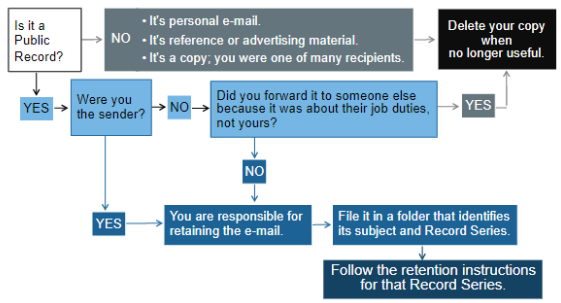IARA County/Local Records Management - Email Classification & Organization
Indiana Archives and Records Administration sent this bulletin at 11/22/2021 09:25 AM EST
|
Hi County/Local Agencies,
This week IARA will be covering some e-mail retention tips. This will be a two-part series with Part 1: Classification and Organization of e-mail this week, and Part 2: Retention and Disposition next week. E-mail is one of the more complicated electronic records to manage so we hope the information below will prove helpful. If you ever have questions about e-mail and records management, please reach out to the Electronic Records Program team at erecords@iara.in.gov.
Classification
Classifying e-mail is half the records management battle. A good overarching rule to keep in mind is that e-mail is not a record series in and of itself, because Indiana engages in format agnostic records management. This means it is not the format of the record, but the type of information contained in the record that will determine its retention and disposition.
Below IARA has broken e-mail retention down into some at-a-glance bullet points to help you better categorize. We hope that armed with the rules above and the bullet points below you will find e-mail management less of a battle.
Note: When we say “e-mail” below, we mean both the body of the e-mail and any attachments.
E-mails, tasks, and calendar appointments are:
- Records when they document your agency business activities.
- Non-records when they are not business-related, for example: messages about lunches, holiday party invitations, etc.
E-mails fall under three broad categories of records:
- Permanent – E-mails of permanent status as identified in a retention schedule that may be transferred to the next executive director or similar or may be transferred to the Indiana Archives if determined to have historical value.
- Temporary – E-mails of non-permanent status that are subject to a retention schedule or have an ongoing business or reference use.
-
Non-record – Transitory or duplicate messages that are received by the user, do not have any legal, administrative, fiscal, or historical value, and are not required to be retained. These may be deleted at any point and include, but are not limited to, the following:
- Listserv messages, subscriptions, and other types of bulk communications
- Spam
- Copies of messages that were sent to multiple people and were not created by the user
- Unsolicited sales or promotional messages
- Personal messages that do not convey state business
- Routine agency memos and announcements
- Published reference materials
- Invitations to meetings
- “Thank you” messages
- Replies to routine questions (e.g., requests for your agency’s address or public forms)
- Out-of-office replies
E-mail that is a non-record but has research or reference value can be retained until you no longer need it.
Confidential and Sensitive E-mail:
Your office may also work with confidential or sensitive e-mails. All necessary precautions should be taken to prevent any such information from improper disclosure or deletion prior to its disposition date. Duplicates of these materials must be maintained and destroyed confidentially in the same manner as the originals.
Organization

Screenshot from Electronic Records: E-Mail Management Tips for Indiana Government Employees available on our website at https://www.in.gov/iara/services-for-government/workshops-and-training/online-tutorial-electronic-records-e-mail-management-tips/.
The best strategy when it comes to records management of e-mail is to be proactive. Taking advantage of the tools your e-mail software offers helps you to stay organized. Using folders and subfolders, labeling or tagging, and setting rules to help sort and organize incoming items makes it easier to identify the important things down the road. Regularly cleaning your e-mail of junk mail, reference material that you no longer need, and mass communications can help keep your storage size down and your inbox more controlled.
Actively managing subscriptions also makes a difference. Regularly check your e-mail and unsubscribe from communications like mailing lists, newsletters, bulletins and other things you no longer need, then create inbox rules to send what you do want to keep to sub-folders. Likewise, if you work with confidential e-mails that you need to retain, you may want to clearly label and/or store them in specific folders to promote proper retention.
Limiting personal use of your work e-mail will also help keep your inbox manageable. It is recommended that you not use your work e-mail address for non-business notifications (such as from your bank, your doctor, your health insurance company, LinkedIn, etc.). Delete personal messages when they are no longer needed to keep your inbox tidy.
Sorting and filing your e-mails makes it more efficient to find them when needed and to delete them when it is appropriate. Remember to check both your Inbox and your Sent Items folders!
Part 2: Email Retention and Disposition
*********************************************
Enjoy this season of thankfulness!
AMY CHRISTIANSEN
Records Management Liaison
Indiana Archives and Records Administration
o: 812-929-3882
e: achristiansenjanicki@iara.in.gov |
a: 402 W Washington St, Room W472, Indianapolis, IN 46204

